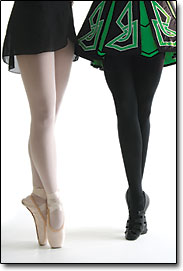An Irish dancer’s lightning-fast, precision feet might blur with speed, but that limb awareness doesn’t extend to arms, which are usually planted squarely on a dancer’s hips or sides.

Modern dancers, on the other hand, are highly aware of their upper limb positioning, findings that suggest rethinking the emphasis on the lower body when developing training programs to keep the elderly functional and mobile, says Susan Brown, Arthur F. Thurnau Professor and associate professor of kinesiology, School of Kinesiology.
Proprioception, sometimes called the sixth sense, is the awareness of positioning and speed of limb movements, says Elizabeth Schweiger, a research assistant at the School of Kinesiology Motor Control Laboratory, whose undergraduate thesis project yielded the surprising results.
Without proprioception, it’s much more difficult to learn new movements, she says. Proprioception declines sharply in the elderly and, unlike traditional rehabilitation, most programs to maintain elderly functionality emphasize working the lower limbs for balance, but ignore the arms. Traditional rehab is task-specific, meaning if the arms need work, the therapist primarily works the arms.
But the dancer findings suggest that exercising just one part of the body — for the elderly, the lower body to increase balance — doesn’t mean limb awareness extends to the upper body. However, upper limb awareness is important for a variety of daily activities such as buttoning shirts, tying shoelaces and manipulating objects like pill bottles, Brown says.
The study, which is the first to show that the nature of elite motor performance may impact limb awareness, also supports the task-specific approach of rehabilitation.
The study compared the proprioception, or limb awareness, of elite Irish and modern dancers, and tested whether normal limb awareness in elite dancers was enhanced through task specific exercises — in this case, dancing. The findings suggest that because modern dancers use their arms much more then Irish dancers, they had a more highly developed upper-limb position sense.
The modern dancers scored nearly 30 percent better in upper-limb awareness tests than the Irish dancers, who aren’t required to use their arms nearly as much as modern dancers.
The dancers performed a series of matching limb tests, which measured how closely they were able to duplicate arm positions. The difference in accuracy, Schweiger says, was about one degree, which may seem small, but actually means the difference between a key missing the ignition or fingers gripping the handle of a coffee cup.
The findings were presented Sunday at the annual conference of the Society for Neuroscience in Chicago.

